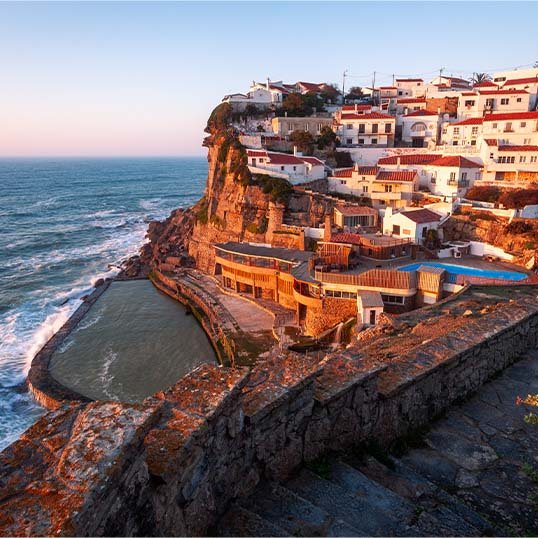The Best Festivities of the Santos Populares
 The
favourite time of year for Lisbon locals, the Santos Populares, is back. Why do
we celebrate the saints at this time of year? Like other Catholic celebrations,
such as Christmas and Easter, these festivities have their origins in a pagan
celebration, the summer solstice, generally celebrated on the 21st of June, the
longest day of the year. The favourite saint of the Lisbon locals and the
city’s patron is Saint Anthony. Interestingly, until 1981, Saint Vincent,
depicted in a statue at Portas do Sol, was Lisbon's patron saint. It was only
in 1981 that Saint Anthony, the "matchmaker" saint, rose to the
position.
The
favourite time of year for Lisbon locals, the Santos Populares, is back. Why do
we celebrate the saints at this time of year? Like other Catholic celebrations,
such as Christmas and Easter, these festivities have their origins in a pagan
celebration, the summer solstice, generally celebrated on the 21st of June, the
longest day of the year. The favourite saint of the Lisbon locals and the
city’s patron is Saint Anthony. Interestingly, until 1981, Saint Vincent,
depicted in a statue at Portas do Sol, was Lisbon's patron saint. It was only
in 1981 that Saint Anthony, the "matchmaker" saint, rose to the
position.
In the past, each neighbourhood celebrated only its patron saint; now, above all, Saint Anthony is celebrated: patron and matchmaker. Lisbon, being the city of joy and animation, extends the celebrations to the maximum, creating an endless festivity throughout the entire month, where fado, popular "pimba” music, and the "marchas populares” reign.
Each of Lisbon's neighbourhoods has its own charm and puts its own stamp on the celebration of the various saints. Let’s explore the best festivities in some of Lisbon's most iconic neighbourhoods.
Alfama
Alfama is the beating heart of the celebrations. This historic neighbourhood is known for its narrow streets and steep staircases. In June, it transforms into a sea of colours, smells, and sounds. The streets are decorated with colourful ribbons and balloons, while the locals prepare grilled sardines and caldo verde.
The Marchas Populares are one of the highlights of the celebrations in Alfama. Groups from each neighbourhood parade through the streets, dressed in traditional costumes, dancing and singing songs that tell stories of the city. These parades are the culmination of many months of preparation and rehearsals and are judged in a competition that highlights the creativity and authenticity of each group.
The famous Santo António Weddings, a tradition dating back to the 13th century, are also part of the festivities. Several couples get the chance to marry in a collective ceremony sponsored by the Lisbon City Council, followed by a parade through the streets of Alfama.
Here, fado is the music of choice, complemented by popular songs that celebrate life in the neighbourhood, while small bands play on various corners. The neighbourhood attracts a diverse crowd, from locals to tourists of all ages who come to experience the authenticity and warmth of the popular festivities.
Alfama é o coração pulsante das celebrações. Este bairro histórico é conhecido pelas suas ruelas estreitas, escadarias íngremes. Em junho, transforma-se num mar de cores, cheiros e sons. As ruas são decoradas com fitas coloridas e balões, enquanto os habitantes locais preparam sardinhas assadas na brasa e caldo verde.
Fun Fact: In the old days, women used to hang an upside down image of St. Anthony behind the door of their homes or rooms, asking him, in a prayer, to find them a suitor. If the prayer didn’t work and the selected "darling” didn’t come to them, some of the women would even take the baby Jesus from St. Anthony's arms as a small act of revenge."

Bairro Alto
Bairro Alto is famous for its nightlife and lively bars and restaurants. This neighbourhood elevates its energy to a new level during the festivities. The streets are adorned with bunting, and communal tables are set up where residents and visitors gather to enjoy traditional foods and wine.
The sound of the marchas populares and the festivities fills the air, making every corner a meeting point for celebration and dancing. Here, the music is an eclectic mix of pop, rock, and traditional Portuguese songs. DJs and local bands keep the party going until dawn, creating an electrifying atmosphere. It is known for attracting a young and international crowd, especially those looking for a night of fun and partying.
Fun Fact: The basil plants we see for sale around this time were traditionally picked by boyfriends who then gave them to their girlfriends, decorating them with quatrains written by them, with declarations of love.

Mouraria
A Mouraria é um dos bairros mais multiculturais. Aqui, a tradição portuguesa mistura- Mouraria is one of the most multicultural neighbourhoods. Here, Portuguese tradition mixes with influences from various parts of the world, creating a unique and diverse celebration. The streets are decorated with lanterns and bunting, and there are stalls selling typical Portuguese dishes as well as specialties from other cultures. The music is also a fusion, with fado meeting international rhythms, creating a vibrant and inclusive atmosphere, with samba circles, concerts scattered throughout the neighbourhood, and much more.
The marches in Mouraria are a true spectacle of cultural diversity. Participants incorporate elements from various cultures, resulting in colourful and lively parades. This neighbourhood attracts a diverse and multicultural crowd, including many tourists looking for an authentic and vibrant experience.
Fun Fact: The popular marches have officially paraded through the Portuguese capital for 84 years. The very first march passed through only two neighbourhoods. The original intention was to showcase the costumes and songs of Lisbon.
Graça
The Graça neighbourhood is known for its stunning views over Lisbon. During the festivities, its streets and viewpoints are decorated with colourful decorations, and the festivities are enlivened by live music, dancing, and a wide range of typical snacks, such as bifanas and grilled sardines. The atmosphere in Graça is particularly friendly, welcoming, and family-oriented, making this neighbourhood a favourite for those who want to celebrate the saints in a more relaxed way.
The marches are characterized by a strong connection to tradition and the local community. The parades include dances and songs that celebrate the history of the neighbourhood and the city. Fado and Portuguese popular music dominate the stages. The neighbourhood attracts a family audience and people of all ages, making it ideal for families with children.
Fun Fact: During the festivities, it is typical to jump over bonfires, which is also a pagan heritage. It is said that couples jumped over the bonfires holding hands in a fertility ritual.

Every year, the capital takes on new colours, a new life, and a lighter summery outfit for the celebrations. The month of June transforms Lisbon into a city full of life, where each neighbourhood brings its own personality to the festivities.
With both national and international visitors, these celebrations offer a unique experience of unity, where everyone takes to the streets to join in and celebrate sharing and community. There is no better way to feel the soul of the city than by participating in the festivities and immersing yourself in the local culture. Come and discover the charms of the Santos Populares in Lisbon!


